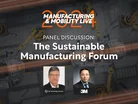Manufacturing & Mobility LIVE: Sustainable Manufacturing

At Manufacturing & Mobility LIVE, the Sustainable Manufacturing Forum brought together industry leaders Rodney Duran, Area Vice President and Manufacturing Practice Head at L&T Technology Services and Sean Wu, former Senior Vice President of Manufacturing and Supply Chain APAC at 3M.
They shared insights into impactful strategies, challenges, and the future of sustainable manufacturing.
To watch The Sustainable Manufacturing Forum, click here.
Tackling environmental impact
Sean begins by emphasising the importance of reducing waste as a central strategy for sustainability. Waste minimisation, he notes not only lowers environmental impact but also cuts costs by improving efficiency.
Rodney agrees, adding that modernising outdated equipment is vital.
While legacy machines may still function, they often consume excess energy and generate unnecessary waste.
Rodney highlights the value of censoring equipment to monitor parameters such as temperature and humidity.
This enables manufacturers to detect inefficiencies in real-time and minimise energy loss.
For example, optimising insulation in ovens and integrating smart controls can significantly reduce heat wastage.
Both speakers stress that addressing waste at its source and upgrading processes are foundational to sustainable manufacturing.
Scaling and cultural transformation
Scaling sustainability efforts requires more than technology – it demands a cultural shift.
Rodney underscores the importance of establishing key performance indicators (KPIs) for sustainability.
By embedding these goals into daily operations and linking them to financial outcomes, organisations can foster accountability.
Sean emphasises the role of continuous improvement and leadership. Regular walk-throughs on shop floors to inspect projects, coupled with recognition for employees’ contributions, help build a culture of sustainability.
He highlights the necessity of sharing best practices across global operations through platforms that facilitate collaboration and knowledge exchange.
Overcoming barriers to sustainable practices
Both speakers acknowledge that financial constraints often hinder sustainability initiatives.
Sean cites the challenge of balancing initial investments in renewable energy or advanced equipment against long-term returns. However, he points to innovative approaches, such as co-investment models and partnerships with local governments, which can ease the financial burden.
Rodney adds that creative engineering and holistic planning are critical. By combining multiple solutions – ranging from product design changes to process optimisations – organisations can achieve sustainability goals without incurring prohibitive costs.
He also calls for a shift in mindset: sustainability should be seen as a strategic imperative rather than an obligation.
The role of renewable energy
Discussing the shift towards renewable energy, Rodney shares an example of a company in Mexico that installed solar panels over car parks, simultaneously providing shade for employees and generating electricity.
Such innovative approaches demonstrate how renewables can be seamlessly integrated into manufacturing operations.
Sean advocates for challenging engineers to design manufacturing processes that minimise cycle times, waste, and energy consumption. He shares an example of redesigning curing methods in manufacturing, which improved efficiency by 50% while reducing energy usage.
This underscores the importance of leveraging engineering talent to create solutions that balance environmental and operational goals.
Continuous evaluation and future outlook
Both panellists agree on the importance of continuously evaluating sustainability strategies. Sean highlights the need to adapt to evolving regulations and emerging technologies, ensuring that strategies remain relevant and effective.
Rodney emphasises the value of long-term roadmaps to guide organisations and embeds sustainability into their core objectives.
Looking ahead, the forum touches on the potential of technologies like AI and additive manufacturing to revolutionise sustainability in manufacturing.
Sean and Rodney stress that while no single solution exists, combining multiple approaches tailored to specific industries and locations can drive meaningful progress.
Purpose-driven sustainability
Sean concludes by asserting that sustainability must be driven by purpose – a commitment to improving the environment, communities and future generations.
He emphasises that this purpose aligns with stakeholder expectations, regulatory requirements, and societal responsibilities. Rodney echoes this sentiment, stating that when sustainability is rooted in purpose, it becomes second nature to adopt necessary changes and innovations.
To watch The Sustainable Manufacturing Forum, click here.
Essential diary dates for 2025
Discover the essential diary dates for Manufacturing Digital, as well as its sister publications – Procurement Magazine, Supply Chain Digital and Sustainability Magazine.
To follow Manufacturing LIVE on LinkedIn, click here.
To enter for the Global Procurement & Supply Chain Awards, click here.
- Procurement & Supply Chain LIVE Singapore | 11 February
- Procurement & Supply Chain LIVE: Sustainability | 5-6 March
- Sustainability LIVE: Net Zero | 5-6 March
- Procurement & Supply Chain LIVE Dubai | 29 April
- Sustainability LIVE Chicago | 28-29 May
- Procurement LIVE Chicago | 28-29 May
- Supply Chain LIVE Chicago | 28-29 May
- Manufacturing & LIVE Chicago | 28-29 May
- Procurement & Supply Chain LIVE London | 23-24 September
- Procurement & Supply Chain Awards | 24 September
Explore the latest edition of Manufacturing Digital and be part of the conversation at our global conference series, Manufacturing LIVE.
Discover all our upcoming events and secure your tickets today.
Manufacturing Digital is a BizClik brand.


